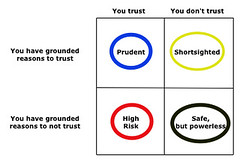My friend and colleague Leonardo Maldonado recently pointed out a great problem in the way that most of the social networking websites look at connections among people online. I believe that Leonardo sees this as a viewpoint from the USA, and after my travels, I can understand why. Leonardo says: No somos Gringos!!!! (“We aren’t Gringos”) speaking about his background of being from Chile… with the prevailing view that most Americans (from the USA) are focused only on transactional relationships (the kind that you might have if you walk into a coffee shop and ask for just a coffee) versus longer term, deeper “relational” relationships. In this post, Leonardo says: “No nos miramos como agentes individuales que van realizando conexiones con otros para obtener beneficios operacionales tácticos… no usamos nuestras relaciones…. somos nuestras relaciones!!!”. (Rough translation: “We don’t look as individual agents that are going to realize connections with others to obtain tactical operational benefit…. we don’t use our relationships… we are our relationships!”)
The Trust Matrix: Finding Opportunity in Risk
This blog is about “going exponential” with a community of fellow entrepreneurs. It is through building strong communities (or some would say ecologies) that a group of entrepreneurs can create the greatest shared outcomes with each other and for themselves. (In this case, I am using “entrepreneur” to refer to both traditional entrepreneurs and in-company “intrapreneurs”). The following matrix, shared to me by my business colleague Rafael Panteon, is a thought device to help entrepreneurs clarify where greatest risk is (or can be) while dealing with others. To be in business with someone else (whether as a customer or a partner) there must be trust in order to move quickly. If there is minimal trust, then typical interactions between parties take a long time to coordinate. Parties who have known each other for a long time, and have strong reasons to trust each other can start an initiative together with minimal time, perhaps just a short phone call. In reviewing the four quadrants:
- Prudent: You trust the person that you are dealing with, and you have a history of reasons to trust them. This is the day in and day out of business; Risk is minimal compared to other interactions, because of a shared history or reason that loyalty will be enforced in the relationship.
- Shortsighted: In the category to the upper right, “you don’t trust” but you have a reason to trust the party that you are dealing with. This lack of trust prevents actions to take place, and is a sign of limited opportunity for the business or community that the parties come from.
- Safe, but Powerless: The lower right quadrant is safe- for you might have reasons to not trust the parties that you are dealing with, and correspondingly, you decide not to trust (and not to take action together). There might be safety in not going to the market, but there will resultingly be no trade, no commerce, and therefore no wealth.
- High Risk: The fourth quadrant- to the lower left- is where real risk and therefore real opportunity is. In this quadrant, prospective business partners have little certainty on working with each other… as an example, perhaps in engaging an expert that lives in a different country would fall in this category. In this case, entrepreneurs must learn and practice how to open themselves up to these opportunities, without making themselves vulnerable
Why is there “real opportunity” in this lower left hand quadrant? The answer is truly a numbers game… there will always be more people in the world that there are reasons to not do business with them (e.g. this other person is in a different country, I know nothing about their culture, etc.) But if you can find a way to take care of creating trust and strong commitments between the parties that you are doing business with, great opportunity can come from these interaction, far exceeding the numbers of opportunities that will ever be served by your direct network of quadrant #1.
